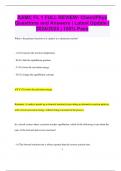Summary
HBO-ICT, Year 1, Net Engineering 1, Book Summary
- Module
- Institution
- Book
Important notions/concepts from the books “Computer Networking...” and “Network Forensics...”. This summary has also been improved and complemented by important information on the Net Engineering 1 exam. The grade I got with the first version of this summary is a 7.5.
[Show more]













